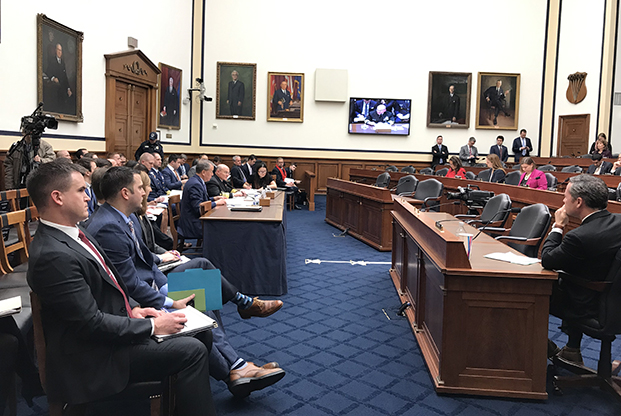
Under Secretary of Defense for Policy John Rood and Joint Staff Director of Operations Vice Adm. Michael Gilday testify before the House Armed Services Committee on Jan. 29. Staff photo by Jennifer-Leigh Oprihory.
Active Duty and National Guard troops will continue to deploy to the US-Mexico border through the end of fiscal 2019, Under Secretary of Defense for Policy John Rood told House legislators on Tuesday.
As of Jan. 29, there are approximately 2,350 Active Duty troops deployed to the border, down from about 5,900 in November 2018, according to the Defense Department. There also are about 2,270 Guard troops, of which some 150 are from the Air National Guard, the National Guard Bureau told Air Force Magazine in an email.
The total price tag for these deployments wasn’t provided, though Joint Staff Director of Operations Vice Adm. Michael Gilday—who testified alongside Rood before the House Armed Services Committee—said it will cost about $132 million to keep Active Duty forces at the border through the end of January. It cost DOD $103 million to send Guardsmen to the border in fiscal 2018, and the projected cost to maintain a Guard presence there through the end of fiscal 2019 is $448 million, added Gilday.
The troops are supporting US Customs and Border Protection by providing aviation and engineering support, hardening US ports of entry, providing temporary barriers, and helping to put concertina wire in place, wrote Rood and Gilday in prepared testimony.
On Jan. 11, Acting Defense Secretary Patrick Shanahan also approved a request from the Department of Homeland Security for additional Active Duty military personnel to operate mobile surveillance cameras in Arizona, California, New Mexico, and Texas until Sept. 30.
“Guard personnel provide air and reconnaissance support, operational support, construction and maintenance of border infrastructure, and logistical support,” NGB spokesman Kurt Rauschenberg told Air Force Magazine via email. “This includes detection and monitoring, non-intrusive inspection of cargoes, paralegal work, telecommunications equipment installation and maintenance, heavy equipment operation, physical infrastructure maintenance, administrative and also logistical assistance.”
Guard troops are also assisting with “counterdrug surveillance and intelligence gathering” to support federal initiatives aimed at combating “transnational criminal gangs,” human trafficking, and the illegal smuggling of drugs and firearms, Rauschenberg said.
Gilday said the situation on the border continues to evolve, and noted that DOD has attempted to downsize the Active Duty force and equipment presence whenever possible while staying mindful of readiness and cost. He emphasized “it’s not a steady-state demand signal.”
Neither Rood nor Gilday could identify a benchmark that would tell them Active Duty troops could be withdrawn from the border, or provide a metric by which to gauge the effectiveness and/or impact of the Active Duty force’s employment.
When pushed by Congress to explain why Active Duty forces were necessary at all, Gilday said flexibility and the ability to rapidly deploy were key.
“Broadly, we’re taking a look at these requirements across the Total Force and we’re trying to see which forces are best suited for the task, and who [is] readily available,” Gilday said. “And so, in one’s mind’s eye, they may think that the National Guard is just a gigantic organization that we continue to draw from for years and years. For a decade, in fact. And we just can’t.”
However, Gilday also acknowledged the skill set required of troops at the border isn’t exclusively military. “It’s not a war zone along the border,” he said, noting that DHS personnel could do the same work.
In a press gaggle following the hearing, HASC Ranking Member Rep. Mac Thornberry (R-Texas) told Air Force Magazine he was satisfied with the witnesses’ justification of employing Active Duty troops at the border, but would have liked the witnesses to elaborate more on “the concern about Guard troops and their deployment cycles.”